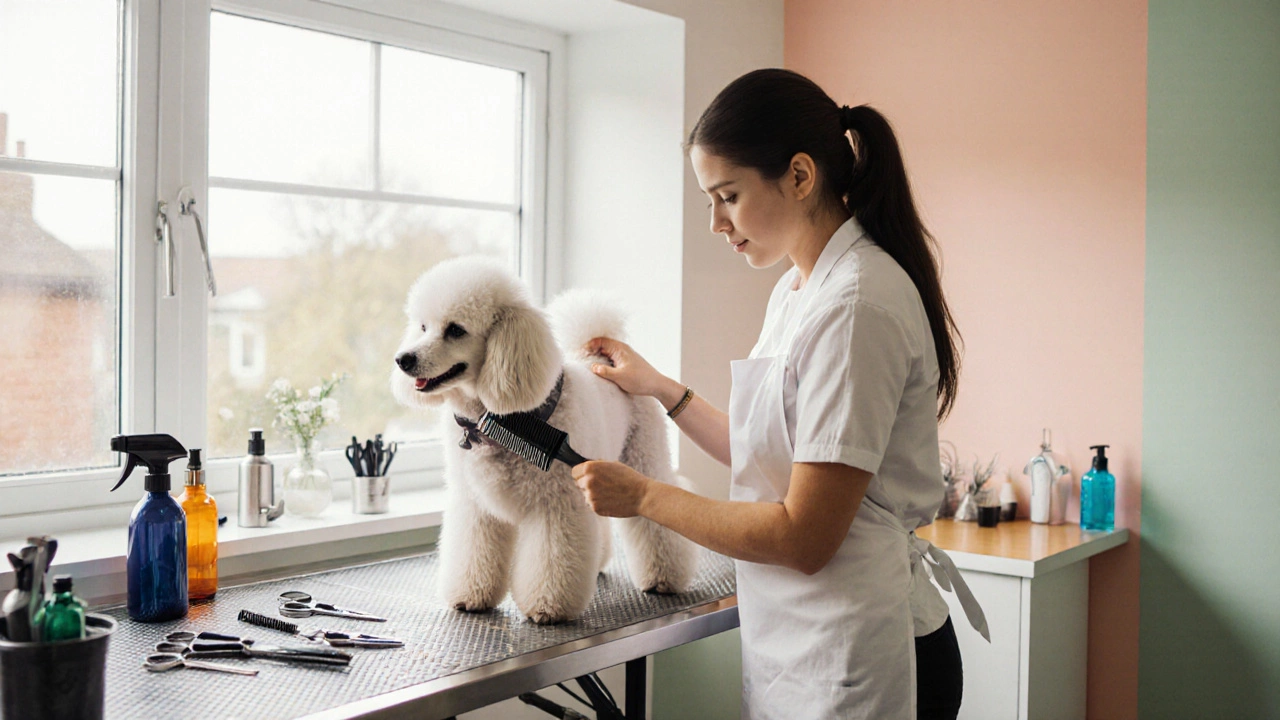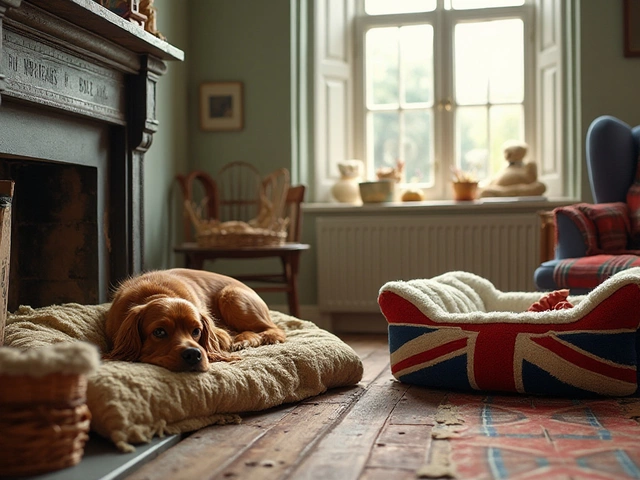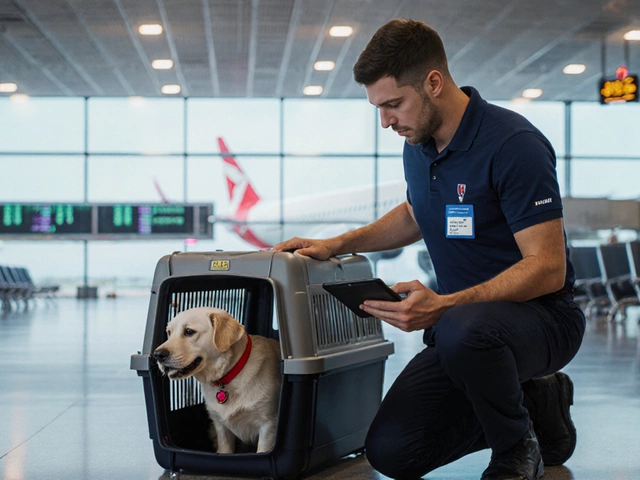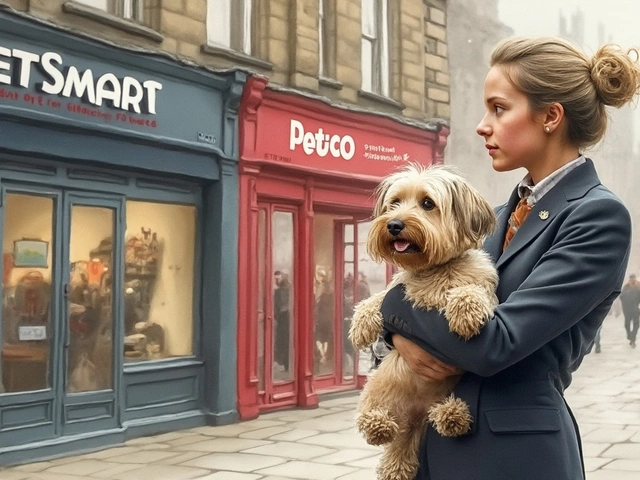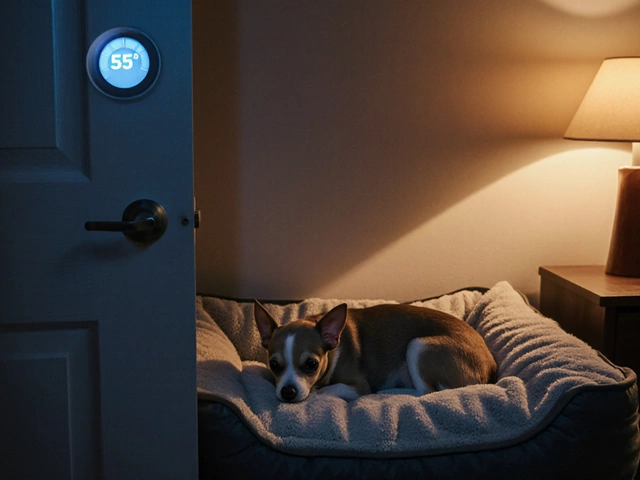Dog Grooming Income Calculator
Estimate Your Earnings
Your Estimated Income
Annual Gross Income
Annual Net Income
Notes: Estimates based on 20 working days per month (240 days/year) and the business model you selected. Actual earnings may vary based on client retention, seasonal fluctuations, and operational efficiency.
For reference: The UK average for dog groomers is £18,000-£45,000 annually. Your results show you're above/below the average based on your inputs.
Ever wondered if you can actually pay the rent by clipping a poodle’s coat? The short answer is yes, but the journey is a mix of skill, business savvy and the right numbers on paper.
Dog Groomer is a professional who cleans, trims and styles dogs for health, safety and aesthetics. In the UK, a full‑time groomer can earn anywhere from £18,000 to over £45,000 a year, depending on location, experience and how they charge.
What a Typical Day Looks Like
Most groomers start their day by checking the appointment book, prepping stations, and sanitising tools. A 45‑minute grooming slot usually includes a bath, blow‑dry, nail trim, ear cleaning and a breed‑specific cut. Busy salons can see 8‑10 dogs a day, while mobile groomers might handle 4‑6 due to travel time. Knowing the routine helps you estimate how many pets you need to serve to hit your income target.
How Much Can You Really Earn?
Pay structures fall into three buckets:
- Hourly wages - most entry‑level positions start at £9‑£12 per hour. In high‑street locations like London or Bath, rates climb to £15‑£18.
- Commission per groom - many salons give 30‑50% of the service price. If you charge £45 for a standard groom, a 40% commission nets you £18 per dog.
- Owner’s profit - running your own business lets you keep the full price after costs. A well‑priced package at £70 can yield a net profit of £35‑£40 per dog once you subtract supplies, rent and taxes.
Putting the numbers together, a groomer who does eight dogs a day at a £40 commission (≈£16 per dog) makes about £12,800 a month before tax - roughly £153,600 a year. Real‑world figures are often lower because of downtime, holidays and client cancellations, but the math shows the ceiling.
Key Costs to Keep in Mind
Every pound you earn is offset by expenses. Below is a quick rundown of the biggest line items for a full‑time groomer.
| Expense | Average Cost (GBP) |
|---|---|
| Rent / Salon Space | £800‑£1,500 |
| Utilities & Internet | £100‑£150 |
| Pet Grooming Equipment | £200‑£350 (depreciation) |
| Insurance (Public Liability & Professional) | £70‑£120 |
| Professional Certification Fees | £30‑£60 |
| Marketing & Advertising | £150‑£300 |
| Supplies (shampoo, towels, clippers) | £120‑£200 |
| Transport (if mobile) | £100‑£250 |
When you subtract these costs from gross earnings, a salaried groomer in a bustling city might net £22‑£28k annually, while an independent salon owner can comfortably clear £35‑£45k after tax.
Pathways to Higher Earnings
There are three proven routes to boost profit:
- Specialise in high‑margin services - colour‑blending, creative cuts, or “spa” packages can command £80‑£120 per session.
- Build a loyal client base - repeat customers reduce marketing spend and fill gaps between bookings. A retention rate of 70% can raise monthly volume 20% without extra ads.
- Expand services - add retail (shampoos, brushes), pet‑boarding partnerships, or boarding‑day‑care. Bundling a grooming session with a retail purchase adds 15‑25% to average ticket size.
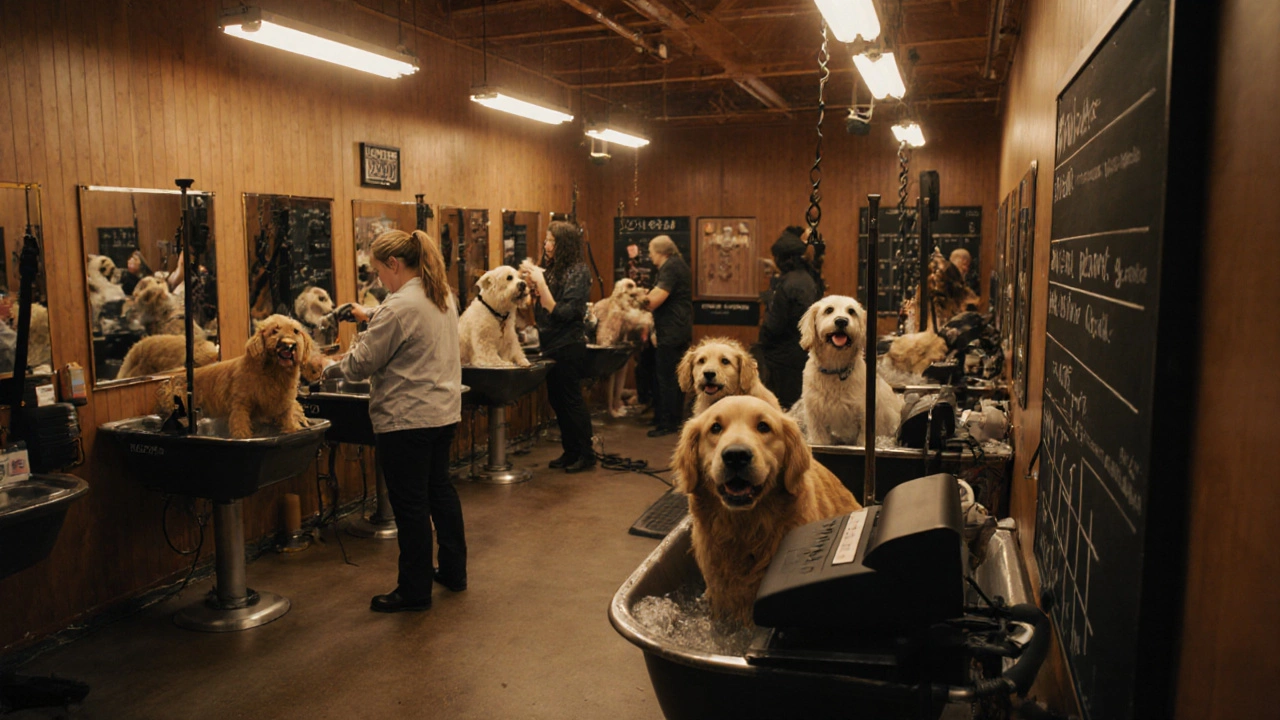
Do You Need Formal Training?
While you can start with on‑the‑job learning, most reputable salons look for a Professional Certification from a recognised body. In the UK, the most common credentials are:
- National Dog Groomers Association (NDGA) Level 2 - covers breed standards, safety and client handling.
- City & Guilds Level 3 in Pet Grooming - recognised by many employers and gives a solid base in hygiene and equipment maintenance.
Courses cost £500‑£1,200 and typically last 4‑6 weeks. Many schools also offer apprenticeships where you earn while you learn, helping to offset tuition.
Choosing the Right Business Model
Three main formats dominate the market. Use the table below to see which aligns with your financial goals, lifestyle and risk appetite.
| Model | Up‑front Investment | Potential Net Income | Flexibility | Risk Level |
|---|---|---|---|---|
| Employee at Salon | £0‑£500 (uniform, tools) | £18‑£30k | Low - fixed schedule | Low |
| Own Grooming Salon | £15k‑£30k (rent, fit‑out) | £35‑£55k | Medium - set hours | Medium‑High |
| Mobile Grooming Van | £12k‑£20k (van, equipment) | £30‑£45k | High - travel anywhere | Medium |
If you value low risk and steady pay, start as an employee. If you crave independence and higher upside, consider a salon or a Mobile Grooming Van. The mobile route eliminates rent but adds fuel, vehicle maintenance and a need for a reliable booking system.
Essential Tools & Equipment
Good gear not only speeds up work, it protects you from injury and keeps clients happy. A starter kit typically includes:
- Professional‑grade clippers (e.g., Andis UltraEdge)
- Stainless‑steel grooming tables with hydraulic lift
- High‑velocity dryer with variable heat settings
- Pet‑specific shampoos, conditioners and detangling sprays
- Safety gloves, ear‑cleaning solutions and nail grinders
Investing in durable Pet Grooming Equipment can cost £1,200‑£2,000, but it reduces replacement frequency and improves client perception.
Legal & Insurance Requirements
Running a grooming operation in the UK means you need a Business License from your local council and appropriate insurance. Public liability coverage (minimum £2 million) protects you if a dog gets injured on your premises. Professional indemnity insurance covers claims about improper grooming or missed health issues.
Annual premiums range £70‑£150 for a solo practitioner, rising to £200‑£300 once you employ staff. Skipping insurance can cost you far more if a mishap leads to a lawsuit.
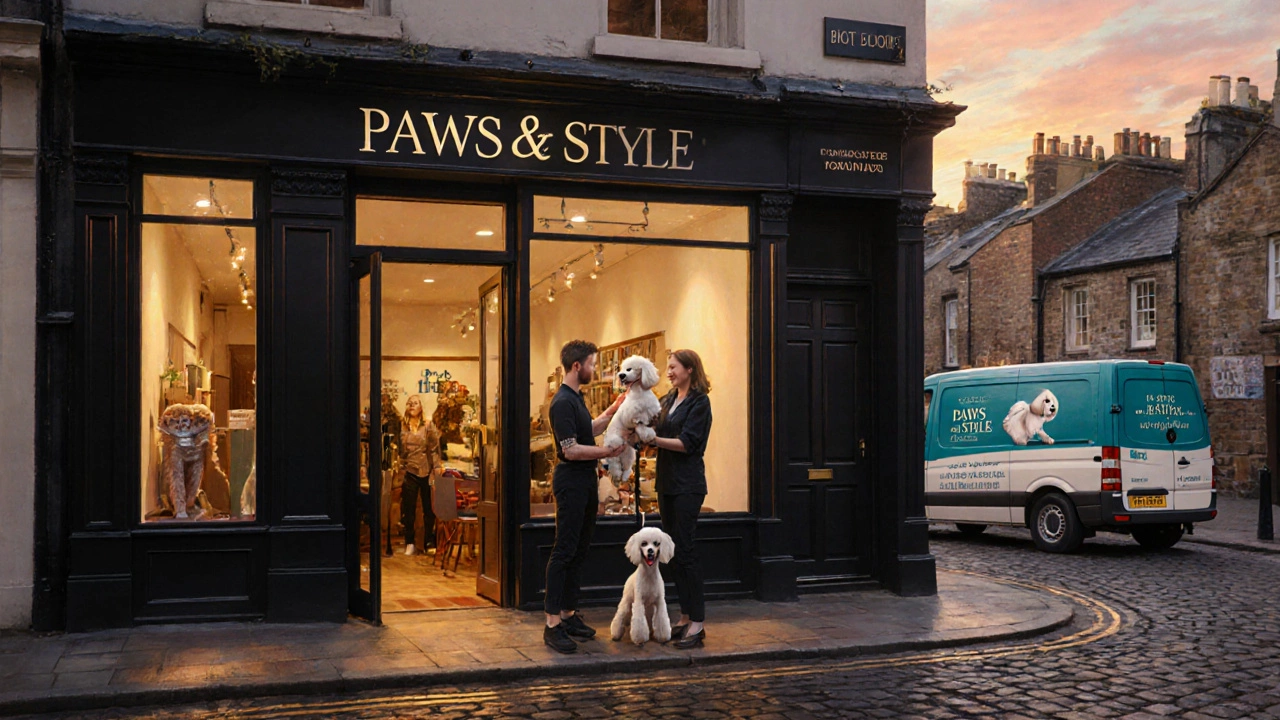
Marketing Your Grooming Services
Even the best groomer needs a pipeline of bookings. Effective tactics include:
- Local SEO - claim your Google Business profile, add keywords like "dog grooming Bristol" and encourage happy owners to leave 5‑star reviews.
- Social media showcases - post before‑after photos on Instagram and Facebook. Tag the breed and use hashtags (#DogGrooming, #BristolPets) to reach local fans.
- Referral discounts - give existing clients a £5 voucher for each new dog they bring in.
- Partnerships - team up with local vets, pet stores or dog trainers for cross‑promotion.
Most groomers allocate about 10‑15% of their projected revenue to marketing, which pays off in higher booking rates and better client retention.
Real‑World Stories: From Apprentice to Business Owner
Emma, 28, started as a part‑time assistant at a Bristol salon earning £9 hour. After completing the NDGA Level 2 course (£800) she moved to a full‑time role, making £22 k in her first year. Within two years she rented a small space, invested £12 k in equipment, and now runs her own boutique called "Paws & Style". Her 2024 profit after expenses sits at £38 k, and she plans to launch a mobile unit next summer.
James, 35, chose the mobile route straight away. He bought a used van for £14 k, fitted it with a fold‑down table and a compact dryer. By focusing on affluent neighbourhoods around Bath and Cheltenham, he commands £85 per full groom and averages 5 jobs a day. After fuel, insurance and van depreciation, his net take‑home is around £31 k per year - well above the UK median salary.
Bottom Line: Can You Make a Living?
Yes, but success hinges on three pillars: solid grooming skills, a clear business model, and disciplined financial planning. If you’re willing to invest in training, secure the right insurance and market yourself consistently, a dog grooming career can comfortably replace a typical 9‑to‑5 job.
Quick Takeaways
- Average UK dog groomer income ranges £18k‑£45k, with owners earning up to £55k after costs.
- Key startup costs: equipment (£1k‑£2k), insurance (£70‑£120), training (£500‑£1,200).
- Three main paths - employee, salon owner, mobile groomer - each with distinct cash‑flow profiles.
- Specialising, retaining clients, and offering add‑on products boost profit margins.
- Legal basics: Business license, public liability and professional indemnity insurance.
How much does a dog groomer earn in the UK?
Salaried groomers typically earn £18,000-£30,000 per year. Salon owners and mobile groomers can net £35,000-£55,000 after expenses, depending on volume and pricing.
Do I need a formal qualification to start grooming?
It’s not mandatory, but most employers prefer a recognised certification such as NDGA Level 2 or City & Guilds Level 3. Courses cost £500‑£1,200 and improve both skill and employability.
What are the biggest expenses for a grooming business?
Rent, insurance, equipment depreciation, supplies and marketing are the main outgoings. Expect monthly costs of £1,500‑£2,500 for a modest salon.
Is mobile grooming more profitable than a brick‑and‑mortar salon?
Mobile grooming cuts rent but adds fuel, van maintenance and travel time. Profit can be similar; success depends on pricing, client density and efficient routing.
How can I attract repeat customers?
Offer loyalty cards, send reminder texts before appointments, and follow up with a post‑groom thank‑you email. Consistent quality and a friendly vibe keep owners coming back.

